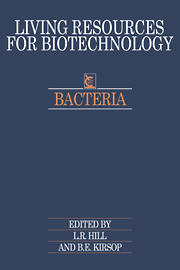Book contents
1 - Resource centres
Published online by Cambridge University Press: 04 August 2010
Summary
Nature of the resource
Living and authenticated cultures of bacteria are essential in virtually all practical applications of bacteriology, whether for routine work or for research. Such cultures are needed as controls, sources of special products, indicators of particular reactions or interactions; as representatives of their kind, or species (important for comparative identifications); as standards. Far from detracting from these ‘classical’ needs, the advent of the biotechnology of today has simply added more user needs, often, however, with a demand for greater amounts of information about the cultures.
There are three principal elements that convert a culture, or collection of cultures, into a ‘resource’. First is the culture itself, successfully preserved in a viable state. If viability cannot be maintained, either technically or simply through default, then only the information that may have been published is a resource: to exploit this limited resource a new isolate has to be obtained. Second is the information recorded about the culture. This includes such documentation as the history of the culture, original source, and also a record of the properties of the culture. The information may be little or exhaustive, but the preservation of cultures without information means they form a substantially less useful resource. Third is the availability of the culture, to enable its further application. However well preserved and well documented, a culture cannot be regarded as a ‘resource’ if it is not available: at best, it is a resource solely for its owner. Availability may, of course, be subject to restrictions or conditions; for example, hazardous bacteria (see Chapter 4) or patent strains (see Chapter 6) may not be universally available.
- Type
- Chapter
- Information
- Bacteria , pp. 1 - 21Publisher: Cambridge University PressPrint publication year: 1991



